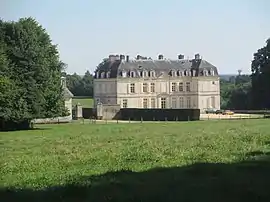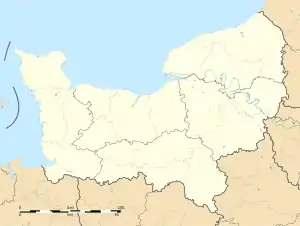Rémalard en Perche
Rémalard en Perche (French pronunciation: [ʁemalaʁ ɑ̃ pɛʁʃ], literally Rémalard in Perche) is a commune in the department of Orne, northwestern France. The municipality was established on 1 January 2016 by merger of the former communes of Bellou-sur-Huisne, Dorceau and Rémalard (the seat).[3]
Rémalard en Perche | |
|---|---|
 The chateau of Voré in Rémalard en Perche | |
Location of Rémalard en Perche | |
 Rémalard en Perche  Rémalard en Perche | |
| Coordinates: 48°25′44″N 0°46′30″E | |
| Country | France |
| Region | Normandy |
| Department | Orne |
| Arrondissement | Mortagne-au-Perche |
| Canton | Bretoncelles |
| Intercommunality | Cœur du Perche |
| Government | |
| • Mayor (2020–2026) | Patrick Rodhain[1] |
| Area 1 | 50.68 km2 (19.57 sq mi) |
| Population | 1,898 |
| • Density | 37/km2 (97/sq mi) |
| Time zone | UTC+01:00 (CET) |
| • Summer (DST) | UTC+02:00 (CEST) |
| INSEE/Postal code | 61345 /61110 |
| 1 French Land Register data, which excludes lakes, ponds, glaciers > 1 km2 (0.386 sq mi or 247 acres) and river estuaries. | |
Notable buildings and places
- Boiscorde Arboretum is a 15-hectare arboretum featuring over 500 trees.[4][5]
- La Petite Rochelle is a 1 hectare botanical garden, open to the public which is classified as a classified as Jardins remarquables by the Ministry of Culture and the Comité des Parcs et Jardins de France.[6]
National heritage sites
The commune has 11 buildings and areas listed as a monument historique.[7]
- Saint-Laurent Church, an eleventh-century church in Dorceau.[8]
- Château de Voré, an eighteenth-century chateau in Rémalard.[9]
- Manoir de Brigemont, a sixteenth-century manor house in Rémalard.[10]
- Le Chatellier Castle Motte, a strategic site for William the Conqueror in his conquest of the Lordship of Bellême in 1077.[11]
- Manoir des Touches, a sixteenth-century manor house in Dorceau.[12]
- Rémalard Church, a twelfth-century church.[13]
- Manoir de Vaujour, a sixteenth-century manor house in Rémalard.[14]
- Voré Tilery, a former tile factory in Rémalard, thought to date from 1828.[15]
- New Farm, a twentieth-century farm in Dorceau that was built to breed the Percheron horse.[16]
- Manoir de Boiscorde, a fifteenth-century manor house in Rémalard.[17]
- Motte castrale dite Le Château, a raised circular enclosure on what was built a shell keep. In 1077, this castle was under siege from William the Conqueror when his son, Robert Curthose locked himself up there.[18]
See also
References
Wikimedia Commons has media related to Rémalard en Perche.
- "Répertoire national des élus: les maires" (in French). data.gouv.fr, Plateforme ouverte des données publiques françaises. 13 September 2022.
- "Populations légales 2020". The National Institute of Statistics and Economic Studies. 29 December 2022.
- Arrêté préfectoral 21 September 2015 (in French)
- "C'est le moment de visiter l'arboretum de Boiscorde". Ouest-France.fr. 12 October 2016.
- "Arboretum du Perche Remalard En Perche : Normandy Tourism". Normandy Tourism, France.
- "Jardin De La Petite Rochelle". Comité des Parcs et Jardins de France.
- "Monument Historique Rémalard en Perche - Mairie de Rémalard en Perche et son village". www.annuaire-mairie.fr.
- "Eglise Saint-Laurent à Dorceau - PA00110795". monumentum.fr.
- "Château de Voré à Rémalard - PA00110897". monumentum.fr.
- "Manoir de Brigemont à Rémalard - PA00110900". monumentum.fr.
- "Motte castrale dite Le Chatellier à Rémalard - PA00132904". monumentum.fr.
- "Manoir des Touches à Dorceau - PA61000036". monumentum.fr.
- "Eglise à Rémalard - PA00110898". monumentum.fr.
- "Manoir de Vaujour à Rémalard - PA00110901". monumentum.fr.
- "Tuilerie de Voré à Rémalard - PA00135527". monumentum.fr.
- "Ferme Neuve à Dorceau - PA61000048". monumentum.fr.
- "Manoir de Boiscorde à Rémalard - PA00110899". monumentum.fr.
- "Motte castrale dite Le Château à Rémalard - PA00132903". monumentum.fr.
This article is issued from Wikipedia. The text is licensed under Creative Commons - Attribution - Sharealike. Additional terms may apply for the media files.